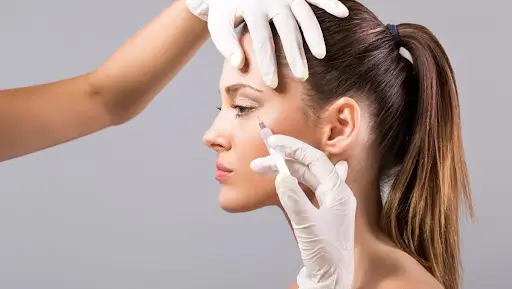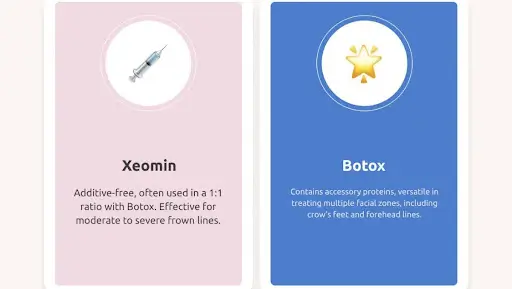Ever wondered why those lines show up on your face as you age? Let's head over to the science behind wrinkles and see how treatments like Xeomin and Botox work to curb them. The role of facial muscles in wrinkle formation Your face's 43 muscles attach directly to your skin, unlike other body muscles. This …

Ever wondered why those lines show up on your face as you age? Let’s head over to the science behind wrinkles and see how treatments like Xeomin and Botox work to curb them.
The role of facial muscles in wrinkle formation
Your face’s 43 muscles attach directly to your skin, unlike other body muscles. This unique connection lets us make over 10,000 distinct facial expressions. But this same feature makes our faces prone to wrinkle formation.
My facial muscles contract every time I smile, frown, or squint. This creates temporary grooves in my skin. These temporary lines can become permanent fixtures after years of repeated movements. Studies show that wrinkle patterns look remarkably similar whether you’re making expressions or at rest.
Our skin loses its natural bounce and resilience with age. The body produces less collagen and elastin—proteins that keep skin supple—by a lot as time passes. Then our skin can’t bounce back from these repeated muscle contractions, and temporary expression lines slowly become permanent marks on our faces.
How injectables reduce wrinkles
Injectable treatments target wrinkles through an amazing biological process. Botox and Xeomin both use botulinum toxin type A, which comes from the bacterium Clostridium botulinum. Small, controlled doses of this neurotoxin temporarily stop nerve signals to specific facial muscles.
The targeted muscles are now unable to contract despite previously doing so, thereby relaxing. The skin on top of it consequently smoothes out as the muscle relaxes, thereby reducing wrinkles and fine lines.
Keep in mind, however, that neurotoxin treatment is entirely different from filler injections-Xeomin and Botox smooth out muscles to stop wrinkles, but fillers plump up wrinkles that already exist by giving the area beneath the skin volume.
Difference between Botox and Xeomin mechanisms
Botox and Xeomin share the same powerful neurotoxin; their formulations differ in one major way. The very essence of this difference lies in the presence of complexing proteins in Botox surrounding the core neurotoxin. These proteins were deemed to shield the toxin against digestion via the oral route.
Typically, Xeomin is referred to as a “naked injectable” since it only includes pure 150 kDa neurotoxin with no proteins. This more purified form counts because the additional proteins in Botox may, in certain individuals, cause patients to develop antibodies that make it less and less effective over time.
Xeomin and Botox are potency-equal, where 20 units of either is equally potent. Both treatments carry out the cleavage of SNAP-25, a protein required for the release of acetylcholine; results are typically seen within one week and can last from three to six months.
Xeomin vs Botox: What sets them apart?
Xeomin and Botox target wrinkles with the same active ingredient, but they have key differences that could affect your choice. Let’s get into what makes these injectables unique from each other.
The ‘naked injectable’ concept
Xeomin and Botox are different in how they’re made. Xeomin is pure botulinum toxin type A with no extra proteins, which is why people call it the “naked injectable”. Botox, on the other hand, has accessory proteins that wrap around the active neurotoxin molecule.
This difference is more than just marketing talk. Xeomin’s pure form only has the active 150 kDa neurotoxin. The molecular weight is six times lower than versions with added proteins. A special process called XTRACT Technology removes these extra proteins to create this simple structure.
Additives and immune response
Xeomin’s protein-free formula offers a big advantage when it comes to immune response. Botox’s extra proteins might cause your body to develop antibodies over time. These antibodies could block how well the botulinum toxin works, making treatments less effective as you keep using them.
Research shows that up to 83% of proteins in formulas with complexing proteins don’t help with treatment. These extra proteins might make you more likely to develop resistance. Clinical studies with 2,649 patients showed that only 0.3% of people using Xeomin developed neutralizing antibodies.
The protein amounts are quite different between these products. Xeomin has about 0.6 ng of clostridial protein per 100 units. Botox has about 5 ng per 100 units. This lower “protein load” might help Xeomin cause fewer immune reactions.
Storage and handling differences
These products need different handling care. Botox needs to stay in the refrigerator between 2°C and 8°C before use. You must transport it in a freezer.
Xeomin works differently. Room temperature storage is fine. This makes it easier to transport and more budget-friendly for providers. Xeomin comes in both 50-unit and 100-unit vials, while Botox only has 100-unit vials. Smaller vials help with more precise billing and less waste.
Effectiveness, safety, and cost

Let’s get into practical aspects that might help you decide between these injectables.
How long do results last
Results duration plays a major role when you think about Xeomin versus Botox. Clinical data shows Xeomin results typically last between 3-6 months. Botox effects generally persist for 3-4 months. Some medical professionals report that Xeomin’s results can last longer—up to six months, compared to Botox. It is a typical 3-4 month duration.
Both treatments can last much longer for autonomic conditions like hyperhidrosis, 6-9 months. Your personal metabolism, muscle activity, and treatment area affect how long the effects persist. Results might fade slightly sooner for first-time users as their body adjusts.
Xeomin vs Botox side effects
These treatments share similar side effect profiles because they use the same active neurotoxin. Common injection site reactions include bruising, redness, swelling, pain, and itching. Patients often report headaches after treatment.
More serious side effects, though rare, can include:
- Eyelid ptosis (drooping) occurs in about 18.9% of Xeomin users versus 8.8% with placebo
- Dry eye affects approximately 16.2% of patients
- Difficulty swallowing, mainly with neck treatments
Xeomin’s “naked” formulation might reduce allergic reaction risk compared to Botox.
Cost of Xeomin vs Botox
Cost often shapes treatment decisions. Botulinum toxin injections average about $408 per treatment. Xeomin prices range between $8-18 per unit, while Botox typically costs $10-20 per unit.
Xeomin costs less, but the total treatment expense depends on several factors—your provider’s expertise, location, and treatment area. Insurance covers both products for medical conditions, but rarely pays for cosmetic purposes.
The price shouldn’t be your only deciding factor. Both products maintain a 1:1 unit conversion ratio, which means 20 units of Xeomin equals 20 units of Botox in strength.
Making the right choice for your needs
The choice between Xeomin and Botox ended up being about your specific needs rather than one being definitely “better” than the other. Let me share the main factors that should shape your decision.
Medical history and allergies
A full picture of your medical background matters before starting treatment. Xeomin and Botox might not work for you if you have:
- Allergic reactions to previous botulinum injections
- Breathing difficulties or respiratory illnesses
- Swallowing problems
- Muscle or nerve disorders
These treatments don’t work well during pregnancy or breastfeeding due to unknown risks. Xeomin’s “naked” formulation without accessory proteins might suit you better if additives make you sensitive.
Consulting a qualified provider
A board-certified dermatologist or cosmetic surgeon is vital for the best results. Your consultation should cover:
- Treatment goals and problem areas
- Your complete medical history
- Number of injections needed
- What does it all mean, and side effects
- Current medications or supplements
Stay away from “Botox parties” and discount events—these delicate medications need proper administration. Your provider’s expertise matters more than the specific product they use.
Both Xeomin and Botox offer safe, effective solutions when administered properly. The right choice depends on your specific situation and a detailed discussion with a qualified medical professional.
Conclusion
A detailed look at Xeomin and Botox shows that neither treatment works better than the other in all ways. Each one shines differently based on what you need.
Without doubt, Xeomin’s “naked” formulation comes without complexing proteins. This helps people who worry about building antibody resistance as time passes. The purer makeup could work better for regular users in the long run. It also stays stable at room temperature, which helps both providers and patients.
Botox has been around for decades, and doctors know it well. Patients trust its track record and can predict their results.
Both smooth wrinkles, but Xeomin’s ‘naked’ formula may work better for some, especially if you’ve built resistance to Botox.
Let Elevated Aesthetics analyze your skin and muscle movement to recommend the optimal neurotoxin for your goals.
FAQs
Q1. What’s the expression difference between Xeomin and Botox?
Xeomin is created for the sole purpose of having pure botulinum toxin type A with no accessory or redundant proteins. Botox, on the other hand, contains appurtenant proteins in addition to the active neurotoxin. The other protein defense might, from the body’s viewpoint, have play influence on the response to repeated treatments over a period.
Q2. Which treatment offers the longer duration of advanced goods, Xeomin or Botox?
Xeomin or Botox lasts the usual 3 to 6 months. Still, some interpreters note that Xeomin might last a little longer, perhaps six months against Botox’s usual 3- 4 months. Results might differ collectively as per other parameters, similar to one’s metabolism and muscle use.
Q3. Are there different side effects associated with Xeomin and Botox?
Xeomin and Botox present with astronomically analogous side effect biographies since both contain the same active neurotoxin. Side effects of each include bruising, greenishness, swelling, and headaches. Possibly, because Xeomin carries no redundant proteins, its chances of causing antipathetic responses could be lower than those of Botox.
Q4. How do the Xeomin and Botox prices compare?
Normally, in fact, prices for Xeomin are a little less than Botox. Xeomin goes for about $8-$18 per unit, while Botox generally costs.
Q5. How should I choose between Xeomin and Botox?
The choice between Xeomin and Botox should be based on your circumstances, including your treatment goals, skin type, medical history, and any previous experience with either product. Consulting with a qualified, board-certified provider is crucial in making the best decision for your specific needs.



